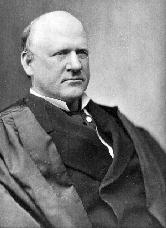
Justice John Marshall Harlan, the great dissenter from the Gilded Age Court
Substantitive Due Process

Justice John Marshall Harlan, the great dissenter from the Gilded Age Court
| Despite its truly bizarre interpretation of the 14th amendment, the power of the Supreme Court grew substantially in the period after Reconstruction. In an America transformed by industrialization, the Court emerged as the most reliable bastion of business power. The Gilded Age Court and economic issues is the subject for today's class, in which we begin our first of three classes reading about John Marshall Harlan. Harlan remains best known for his dissent in Plessy v. Ferguson (which we'll read), but he is also of interest for his views on the relationship between the Constitution and economic policy and the constitutionalism of imperialism. Judicial biographies are among the hardest types of books to write, since the temptation is to rely solely on the published opinion of the Justice in question. Read this book, then, with something of a critical eye. |
READINGS
|
|
Przybyszewski, The Republic According to John Marshall Harlan, pp. 81-117. |
|
|
U.S. v. E.C. Knight (1895) |
|
|
Plessy v. Ferguson (1896) |
STUDY QUESTIONS
|
1.) To what extent did Justice Harlan's dissent in Plessy reflect the spirit of the Civil Rights Act of 1866 (from last class)? What would a civil rights policy as desired by Harlan have looked like? |
|
2.) What was the key issue at stake in E.C. Knight? And why did the Court decide as it did? |
|
3.) Given E.C. Knight, did the Court apply the same rules to its own authority with regard to federalism as it did toward the authority of Congress? |